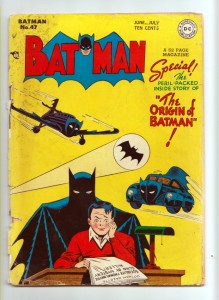When the Batmobile gets brought up in conversation (really though: which one would you rather own?), the image that is often conjured up in our minds is the sleek lines of the finned car made popular throughout the years in the pages of the comics as well as the television and silver screens.
The Batmobile, however, had much different beginnings than many non-Batman fanatics realize. It made its first appearance during the Golden Age and went through quite a few revisions during that era.
- The first Batmobile: Although the term “Batmobile” wouldn’t come along for two more years, the first appearance of the Batmobile was in 1939 in Detective Comics #27 when the caped crusader drove an apparently unmodified red coupe designed by the legendary Bob Kane. In 1941 in Detective Comics #48, that red coupe officially became a 1936 Cord convertible that was named the Batmobile by Bill Finger. It had no bat-like characteristics except for a golden bat hood ornament.
- New design: Just months after the term Batmobile entered canon, a radical design for the car made its appearance in the pages of Batman #5. This design, by Jerry Robinson, was much more like the vision we have of the car today. It was black (or dark blue) with styles that incorporated the visuals of a bat, such as a battering ram bat head with glowing eyes and a swooping fin, or bat wing, on the top. That overall design, with a few tweaks here and there, continued to make appearances as Batman became a fan favorite, even appearing in the Batman daily comics printed in newspapers.
- Cover treatment: In 1943, the Batmobile made its first appearance on a cover, drawn by Dick Sprang for Batman #20. It featured red stripes down the side (perhaps an homage to the original cars) and quickly became the car most comic fans recognized as Batman’s go-to transportation when he wasn’t swinging around Gotham.
- Small changes: In 1948, the Batmobile lost its red stripes in Batman #47, which was penciled by Kane. Instead, the stripes are dark blue both on the cover and in the interior artwork. The design was adjusted by Sprang again in Detective Comics #142, as the car was given smoother lines and fenders to better reflect the post-WWII styles coming out of the Ford, Hudson and General Motors factories.
- Big changes: In 1950, Detective Comics #156 found Sprang unveiling a complete redesign of the Batmobile. The former Batmobile was destroyed in an accident, but the ever-forward-thinking Batman already had plans in works for a new version. This one had influences from the 1950 Studebaker, though was a bit longer. It featured a crime lab right inside of the car, as well as a roof-mounted searchlight that could double as a spotlight for casting the bat-signal. That design was pretty consistent until 1952 in Batman #73 when Sprang changed the color to a dark blue and added a Batman logo on the fin.
- The end of the Golden Age: As the Golden Age of comics came to a close in the mid 1950s, the Batmobile was given its last upgrade of the era. Sheldon Moldoff brought his own vision of the vehicle to the pages of Detective Comics #204, and it featured the dome enclosure over the driver and passenger seats that remained until the 1960s. The Batmobile did lose some of its characteristics in the redesign, however, as the on-board laboratory went away.
Many of these titles are available right here at Superworld Comics, Inc. Always feel free to contact us to find out what we have in stock, or to see if we can help you find Silver Age comic books, Golden Age comic books or comic book original art.




